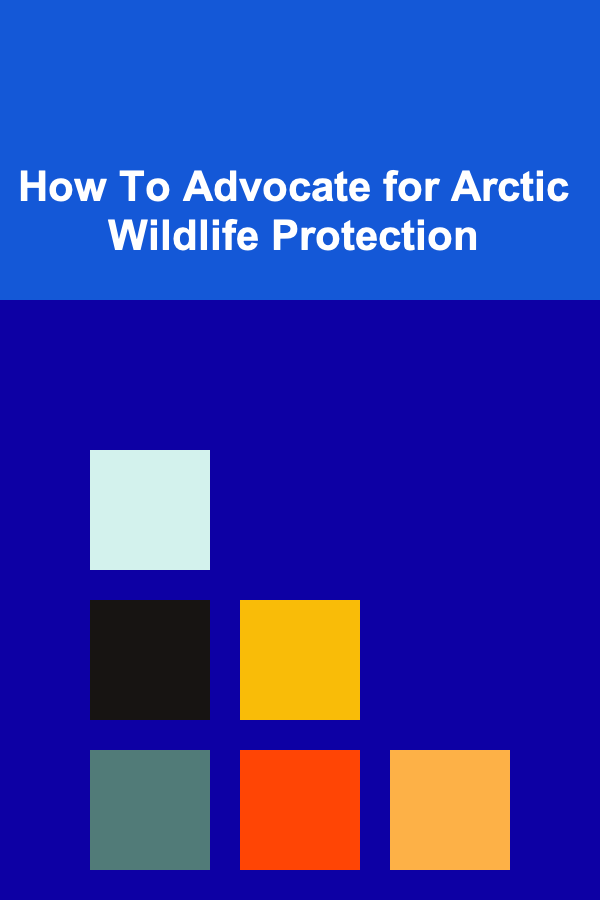
How To Advocate for Arctic Wildlife Protection
ebook include PDF & Audio bundle (Micro Guide)
$12.99$6.99
Limited Time Offer! Order within the next:

The Arctic is one of the most unique and fragile ecosystems on the planet. Known for its extreme conditions and diverse range of species, the region is home to numerous animals that are adapted to some of the harshest climates on Earth. However, this once-pristine environment is now under threat due to climate change, industrial exploitation, and human encroachment. Arctic wildlife is facing unprecedented challenges, making it more important than ever for advocates, organizations, and individuals to step forward and protect these vulnerable species and their habitats.
In this article, we will explore various strategies for advocating for Arctic wildlife protection, understanding the ecological importance of the region, recognizing the current threats to its survival, and examining ways in which individuals and organizations can make a meaningful impact in the fight to preserve Arctic wildlife.
Understanding the Arctic Ecosystem
The Arctic is characterized by its cold climate, ice-covered seas, and diverse landscapes, ranging from tundra to ice sheets. Despite its seemingly inhospitable conditions, it is home to a variety of unique species, including polar bears, walruses, seals, Arctic foxes, and migratory birds. These animals are specially adapted to life in the harsh environment, where temperatures can drop to extreme lows and daylight can be scarce for much of the year.
At the core of the Arctic ecosystem lies the sea ice, which plays a critical role in supporting marine life. The ice forms a habitat for plankton, krill, and other small marine organisms that serve as food for larger animals. In turn, these creatures form the foundation of the Arctic food web, supporting everything from fish to seabirds and marine mammals.
However, the delicate balance of this ecosystem is increasingly being disrupted by a combination of natural and human-induced factors. As the world warms due to climate change, the Arctic is experiencing some of the most significant warming rates on the planet. This warming leads to the melting of sea ice, rising sea levels, and disruptions to the habitats of many species. As a result, the protection of Arctic wildlife has become a matter of urgent concern for conservationists and policymakers alike.
Current Threats to Arctic Wildlife
Several factors are contributing to the decline of Arctic wildlife populations. These threats are intertwined and often exacerbated by one another, creating a complex web of challenges that require a multifaceted approach to address. Here are some of the key threats to Arctic wildlife:
1. Climate Change and Ice Melt
The most significant threat facing Arctic wildlife today is climate change. Global warming is causing the Arctic region to warm at a rate roughly three times faster than the global average. This phenomenon, known as "Arctic amplification," results in the accelerated melting of sea ice, which is crucial for many Arctic species.
For animals like polar bears, seals, and walruses that depend on sea ice for hunting, breeding, and resting, the loss of ice means that they are forced to travel further in search of food, often facing greater risks in doing so. Polar bears, for example, rely on sea ice to hunt seals, and as the ice melts earlier in the spring and forms later in the fall, the bears are left without access to their primary food sources. This has led to a decline in polar bear populations and a reduction in their overall health.
2. Habitat Destruction and Industrialization
Another major threat to Arctic wildlife is the expansion of industrial activities, including oil and gas exploration, mining, and shipping. As the Arctic becomes more accessible due to the retreating ice, commercial interests are increasingly moving into the region, seeking to exploit its natural resources. These activities can lead to habitat destruction, pollution, and disturbances to wildlife.
For example, seismic surveys used to locate oil reserves can disturb marine mammals like whales and seals, whose communication and navigation rely on sound. Oil spills in the Arctic are particularly devastating because the cold temperatures make it difficult for bacteria to break down the oil, leaving it to linger in the environment for years. This can have long-lasting impacts on the health of wildlife populations and their habitats.
3. Overfishing
The Arctic Ocean is home to a range of fish species that are vital to the ecosystem. However, overfishing is a growing concern, particularly with the expansion of fishing operations into previously inaccessible areas due to receding ice. Overfishing threatens the population of fish that Arctic animals rely on for food, and it disrupts the delicate balance of the ecosystem.
Additionally, fishing operations can have a direct impact on species such as the Arctic cod, which is a primary food source for many marine animals, including seals and seabirds. As fish stocks decline, the entire food web suffers, leading to reduced survival rates for many species.
4. Pollution
Pollution is another critical issue for Arctic wildlife. Chemicals like mercury, persistent organic pollutants (POPs), and plastics have found their way into the Arctic through atmospheric and oceanic currents. These toxins accumulate in the environment, particularly in the sea ice and marine organisms.
As the ice melts, these pollutants are released into the ecosystem, where they can poison animals that rely on ice for breeding or hunting. For example, marine mammals such as seals and whales can ingest or absorb harmful chemicals through the food they consume. These pollutants can cause reproductive issues, immune system damage, and even death, further threatening Arctic wildlife.
Advocating for Arctic Wildlife Protection
Now that we understand the threats to Arctic wildlife, it's time to focus on how we can advocate for their protection. Advocacy for Arctic wildlife requires a combination of grassroots action, political pressure, and collaboration with organizations that are already doing significant work in the region. Here are some strategies for advocating for Arctic wildlife protection:
1. Raise Awareness and Educate the Public
One of the most effective ways to advocate for Arctic wildlife is to raise awareness about the threats they face. Many people are unaware of the challenges facing the Arctic ecosystem, and even fewer understand the role that Arctic wildlife plays in the global environment. By educating the public about the importance of protecting Arctic wildlife, we can build a broad base of support for conservation efforts.
Social media, blogs, and community events are powerful tools for spreading awareness. Create and share educational content, engage with online communities, and participate in campaigns to highlight the urgency of Arctic protection. The more people understand the issues at hand, the more likely they are to take action.
2. Support Conservation Organizations
Numerous conservation organizations are working tirelessly to protect the Arctic and its wildlife. These organizations often have the resources, expertise, and networks to influence policy and implement on-the-ground conservation programs. Supporting these organizations through donations, volunteer work, or simply spreading the word can make a significant difference in the effort to protect Arctic wildlife.
Some key organizations working in the Arctic region include the World Wildlife Fund (WWF), Greenpeace, the Arctic Council, and the Polar Bears International. These organizations are involved in advocacy, scientific research, and direct action to address the threats facing Arctic ecosystems and species.
3. Lobby Governments and Policymakers
Political action is essential in securing long-term protection for the Arctic and its wildlife. Governments play a crucial role in setting policies that govern the use of Arctic resources, and they have the power to create protected areas, enforce environmental regulations, and sign international agreements.
Advocacy groups and concerned citizens can lobby governments to enact stronger protections for the Arctic. This may include advocating for the creation of marine protected areas, stronger regulations on industrial activity, and international agreements to limit emissions and address climate change. Individuals can engage with policymakers by writing letters, participating in protests, or supporting political candidates who prioritize environmental protection.
4. Promote Sustainable Alternatives
To address the threats posed by industrialization, it is essential to promote sustainable alternatives to the practices currently harming the Arctic. For example, advocating for sustainable fishing practices, responsible oil and gas extraction, and the reduction of carbon emissions can all help mitigate the damage being done to the Arctic ecosystem.
Supporting sustainable businesses and products is also a way to influence industries to adopt more environmentally-friendly practices. Encourage others to make conscious choices that minimize their environmental impact, such as reducing their carbon footprint, supporting clean energy initiatives, and advocating for the protection of endangered species.
5. Participate in Citizen Science
Citizen science is a valuable tool for gathering data on Arctic wildlife and contributing to research efforts. By participating in citizen science projects, individuals can help scientists collect data on animal populations, habitat changes, and environmental conditions in the Arctic. This data is crucial for understanding the impacts of climate change and industrial activity on Arctic wildlife and can inform conservation efforts.
Many organizations offer opportunities for people to get involved in citizen science, such as monitoring migratory bird populations or tracking polar bear movements. By participating in these projects, individuals can directly contribute to the protection of Arctic wildlife.
Conclusion
Advocating for Arctic wildlife protection is not just an environmental issue; it is a moral imperative. The Arctic is a critical region for global biodiversity, and its wildlife plays an essential role in the health of the planet. By raising awareness, supporting conservation organizations, lobbying for stronger policies, and promoting sustainable practices, we can help ensure that the Arctic and its wildlife are preserved for future generations. The time to act is now, and every effort, no matter how small, can make a difference in the fight to protect Arctic wildlife.

How to Deal with Hard Water Stains in Your Bathroom
Read More
How to Style Your Christmas Tree with Unique Themes
Read More
Mastering Asian-Inspired Cooking at Home
Read More
How to Maintain Your Snowboard: Essential Care Tips
Read More
How to Implement a Disaster Recovery Plan for VMware Environments
Read More
10 Tips for Mentoring Aspiring Scientists
Read MoreOther Products

How to Deal with Hard Water Stains in Your Bathroom
Read More
How to Style Your Christmas Tree with Unique Themes
Read More
Mastering Asian-Inspired Cooking at Home
Read More
How to Maintain Your Snowboard: Essential Care Tips
Read More
How to Implement a Disaster Recovery Plan for VMware Environments
Read More